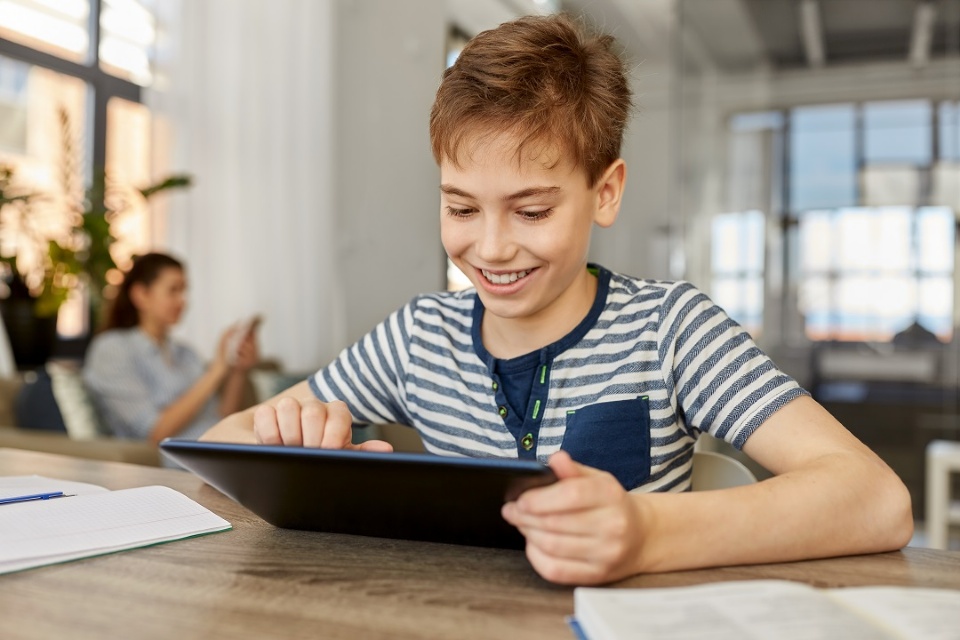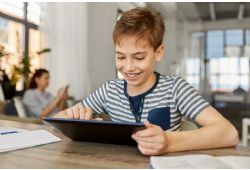When the pandemic struck back in March of 2020, it waged chaos on every aspect of our lives, especially within the world of education. Schools across Quebec closed, and then found themselves in an ongoing ping pong match between in-person and online classes. The biggest take away? Just how flexible educators and administrators have learned to be.
Suddenly, they found themselves trying to navigate through various technological challenges all the while engaging children through a screen. But this challenge also now presents benefits that will extend far beyond the pandemic. One such benefit is how tech-savvy educators and students have become. They are ready to put this knowledge to use, in case future scenarios require it. Some schools may even continue to incorporate an online aspect to their teaching, particularly for older students.Other ways in which good has come out of a terrible situation is one that involves health measures at their most basic level. Christine Krahulec, an elementary educator at the Lester B. Pearson School Board, notes that some positive changes materialized despite struggles. “Since the pandemic, we’ve had to re-assess the air quality in classrooms,” she says. Many schools bought new air purifiers, especially in older buildings. This will benefit students and staff alike for years to come, pandemic or not.Krahulec also adds that for this past year, educators took on the role of ultimate problem-solvers and had to re-evaluate everything. “The social emotional health of students must come first before the academics,” she says. Amidst the usual standardized tests, rubrics, and grading, this is a notion that will remain in many schools. She asserts that the focus should be on bringing joy into the classroom, and also feeling joy as educators. It’s been a difficult road, and educators continue to face stressful situations while trying to remain sane and healthy. This translates into better self-care for many school staff members, which is essential.Another key issue the pandemic shed light on is social and educational inequity. During quarantine, students from certain socio-economic groups found themselves unable to keep up. Assessing the situation, many school boards offered these families free iPads and WIFI so students could be more on par with others. Though we may still be far from bridging the gaps in these inequities, things have at least improved on a certain level.In terms of the 2021-2022 school year, nobody is certain how the situation will unfold. Many educators express hope that some restrictions will ease up, like being able to group students between homerooms rather than in strict bubbles. This will make activities like school-wide projects, recess, and lunch easier to manage. Parents also hope for more “normalcy,” though things may never quite be the same.Ultimately, everyone will have to remain flexible since things can shift at the drop of a hat. “Children are extremely resilient. No matter what restrictions are imposed on them, they always try their best to cooperate,” says Krahulec.
 In The Latest Issue:Latest Issue:
In The Latest Issue:Latest Issue:
- A Bittersweet Farewell
- The new Laval Aquatic Co...
- The End of an Era:
Articles
Calendar
Virtual- ANNUAL TEACHER APPRECIATION CONTEST
- APPUI LAVAL
- ARTS & CULTURE
- CAMPS
- CAR GUIDE
- CCIL
- CENTENNIAL ACADEMY
- CHARITY FUNDRAISING
- CITYTV
- COSMODÔME
- COMMUNITY CONNECTIONS
- COVER STORY
- DINA DIMITRATOS
- ÉCOLE SUPÉRIEURE DE BALLET DU QUÉBEC
- EDITORIALS
- ÉDUCALOI
- EDUCATION
- EMPLOYMENT & ENTREPRENEURSHIP
- FÊTE DE LA FAMILLE
- FÊTE DU QUARTIER SAINT-BRUNO
- FAMILIES
- FESTIVAL LAVAL LAUGHS
- FÊTE DE QUARTIER VAL-DES-BRISES
- FINANCES
- GLI CUMBARE
- GROUPE RENO-EXPERT
- HEALTH & WELL-BEING
- 30 MINUTE HIT
- ANXIETY
- CHILDREN`S HEALTH & WELLNESS
- CLOSE AID
- DENTAL WELLNESS
- EXTREME EVOLUTION SPORTS CENTRE
- FONDATION CITÉ DE LA SANTÉ
- GENERAL
- HEARING HEALTH
- MESSAGES FROM THE HEALTH AGENCY OF CANADA
- MENTAL HEALTH
- SEXUALITY
- SOCIAL INTEGRATION
- SPECIAL NEEDS
- TEENS
- THE NUTRITION CORNER
- THE NUTRITION CORNER - RECIPES
- VACATION DESTINATION
- WOMEN'S FITNESS
- WOMEN'S HEALTH
- HILTON MONTREAL/LAVAL
- HOME & GARDEN
- INTERNATIONAL WOMEN'S DAY
- JAGUAR LAVAL
- LAVAL À VÉLO
- LAVAL FAMILIES TV SHOW
- LAVAL FAMILIES MAGAZINE CARES
- LAVAL URBAN IN NATURE
- LE PARCOURS DES HÉROS
- LES PETITS GOURMETS DANS MA COUR
- LEON'S FURNITURE
- LEONARDO DA VINCI CENTRE
- LFM PREMIERES
- LIFE BALANCE
- M.P. PROFILE
- MISS EDGAR'S AND MISS CRAMP'S SCHOOL
- MISSING CHILDREN'S NETWORK
- NETFOLIE
- NORTH STAR ACADEMY LAVAL
- OUTFRONT MEDIA
- PASSION SOCCER
- PARC DE LA RIVIÈRE-DES-MILLE-ÎLES
- PÂTISSERIE ST-MARTIN
- PIZZERIA LÌOLÀ
- PLACE BELL
- PORTRAITS OF YOUR MNA'S
- ROCKET DE LAVAL
- SACRED HEART SCHOOL
- SCOTIA BANK
- SHERATON LAVAL HOTEL
- SOCIÉTÉ ALZHEIMER LAVAL
- STATION 55
- STL
- SUBARU DE LAVAL
- TECHNOLOGY
- TEDXLAVAL
- TODAY`S LAURENTIANS AND LANAUDIÈRE
- TODAY`S LAVAL
- WARNER MUSIC
- THIS ISSUE
- MOST RECENT
Magazine
Articles ~e 105,7 Rythme FM 4 chemins Annual Teacher Appreciation Contest Appui Laval Arts & Culture Ballet Eddy Toussaint Camps THIS ISSUE MORE...
CONTESTS Enter our contests
CONTESTS Enter our contests
CALENDAR
Events & Activities
COMMUNITY Posts Events
PUBLICATIONS Our Magazine Family Resource Directory
LFM BUSINESS NETWORK Learn more
COUPONS Click to save!
COMMUNITY Posts Events
PUBLICATIONS Our Magazine Family Resource Directory
LFM BUSINESS NETWORK Learn more
COUPONS Click to save!
SUBSCRIPTIONS
Subscribe to the magazine
Un-Subscribe
E-NEWSLETTER Subscribe to our E-newsletter Un-Subscribe
WRITE FOR US Guidelines & Submissions
POLLS Vote today!
E-NEWSLETTER Subscribe to our E-newsletter Un-Subscribe
WRITE FOR US Guidelines & Submissions
POLLS Vote today!
ADVERTISERS
How to & Media guide
Pay your LFM invoice
SUGGESTIONS Reader's Survey Suggest a Listing
LFM About Us Our Mission Giving Back Contact Us
SUGGESTIONS Reader's Survey Suggest a Listing
LFM About Us Our Mission Giving Back Contact Us
 PICK-UP LOCATIONS
Get a copy of LFM!
PICK-UP LOCATIONS
Get a copy of LFM!
TERMS & CONDITIONS Privacy | Terms
ISSN (ONLINE) 2291-1677
ISSN (PRINT) 2291-1677
Website by ZENxDESIGN



 BY:
BY: 
Tweet
Share